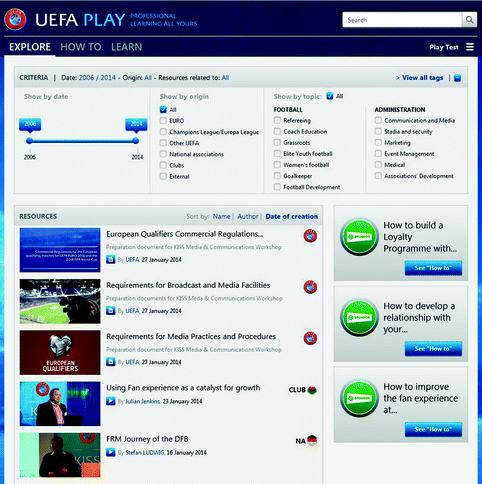Fig. 1.
The various steps of the knowledge management loop including creation, organisation, sharing and use of knowledge.
Steps 1 and 2 show how opportunities to create or collect knowledge are identified, from both the sport events themselves or else from training sessions (mainly workshops). Then after knowledge has been captured, learning objects are created in order to package the good practices into modular elements (step 3). Learning objects then need to be organized and classified (step 4). Three different types of scenarios for knowledge sharing are designed for on-line access on the platform (step 5). These scenarios may either be incorporated into face-to-face scenarios of knowledge sharing (step 6) or else put into application to be used in real life (step 7). Face-to-face scenario may also be put into application (step 8).
3.1 Capturing and Creating Good Practices
Sport events are complex because they include a mixture of different domains of sport management. And there is a need for coherence between the parts. Because the parts are interdependent, the analysis of skills required to manage an event and the good practices generated overtime are interdisciplinary. For instance, marketing operations during an event depend on the characteristics of a stadium which itself is linked with security and safety issues. In addition, management of the media is a key element since the major revenues are driven from broadcasting of the events.
This picture shows rather clearly that good practices are subtle pieces of knowledge and that they cannot be reduced to simple principles underlying each isolated discipline. In fact, the need to generate good practices to better manage sport events is highly related to the interdisciplinary nature of the knowledge involved. Hence, when one tries to identify opportunities to encapsulate knowledge into a learning object, and even though the piece of knowledge is related to a specific domain, say “the media” for instance, the domain should actually be considered just as an entry point. Mastering a domain is predominantly being able to understand the links with and the consequences of realising an activity on the broader scene of the event. If the objective is to try and encapsulate as much of the implicit knowledge of the expert as possible, the good practice needs to display the interdisciplinary nature of the expertise involved. This will have an impact on the design of how the knowledge is organised in the database. It will also have an impact on the search functionalities and in particular it will be a key factor to keep in mind while creating the metadata attached to the learning objects.
Opportunities to encapsulate knowledge may be found during the various phases of the sport event (step 1). Opportunities may be found during the planning phase a long time ahead of the event itself. It may be found in the previous days or during the hours preceding the event. And it may be found during the event itself or else in the debriefing period. Opportunities may also be found during training sessions or workshops. What is captured here is mainly material stemming from presentations (step 2).
Depending on how a scene is captured during an event or at a workshop (with a video or by collecting reports and working documents), it may be necessary to interview experts subsequently in order to match the way an activity has been managed on-site with an explanation of why the activity has been realised in this way rather than in another. Asking the expert to justify a practice is also a good way to pin down alternative actions which might have been less appropriate. This is also a way to refer to failures which are usually difficult to capture, since it is less likely the case that experts will agree to talk about them. One particular interesting way to capture knowledge is story-telling. Experts have been asked to tell stories and to make it explicit what the lessons learned are in each case. Actually, story-telling has proven so strong to encapsulate knowledge that it has been implemented into a specific type of learning object2.
3.2 Building Learning Objects
As online knowledge platforms are being used more and more in training and sharing knowledge and information, the amount of digital resources is beginning to increase and accumulate. Organisation and classification of these resources is becoming a major issue. For the reusability and interoperability, knowledge should be broken down into “chunks”, (small pieces). They define the learning objects (step 3).
Among the many existing definitions of learning objects, IEEE’s learning Technology Standards Committee proposed:
“Learning objects are defined here as any entity, digital or non-digital, which can be used, re-used or referenced during technology supported learning. Examples of technology supported learning include computer-based training systems, interactive learning environments, intelligent computer-aided instruction systems, distance learning systems, and collaborative learning environments.”
The way we use digital resources in our project is close to the way Wiley defines the learning object as “any digital resource that can be re-used to support learning” [8]. This more precise definition is broad enough to include all available resources over a network (online), whether large or small, unique or consisting of a combination of different media.
Thus, the learning object built may be composed of “small digital resources” such as graphic images, videos, audio resources, portable document format (PDF), but also more complex ones, such as synchronized presentations texts and videos, interactive videos, or storytelling combining images, sounds, and interviews.
3.3 Organizing and Storing Learning Objects
Creating Metadata. Some information should be added to describe the learning object and to facilitate the search or the management of the learning object. This information is called metadata. Metadata helps make the resource searchable and reusable.
Metadata consists in descriptive information about digital resources including creation date, publishing date, title, author, description, keywords, photo, size, topics, location, etc. The metadata model must be standard. Hence, IEEE Standard for Learning Object Metadata (IEEE LOM) developed by IEEE LTSC (Learning Technology Standards Committee) has been used.
The content creator or administrator of the database provides metadata. The perception that metadata is complex and technical can be an issue for users. Local standards need to be defined and an easy and flexible tool needs to be provided to maintain the benefit of the metadata. The challenge is to understand how users will use metadata to search and classify information in order to simplify the tagging system and choose the most pertinent metadata fields for the main users.
Metadata is an essential element of the UEFA PLAY knowledge platform. Indeed, the classification of each learning object by topics, origin and date is necessary to enable the selection of resources through filters and tags and to use a full text search engine.
Learning Object Repository. Learning objects are stored in a database called Learning Object Repository. One of the key features of the repository is centralization. A wide variety of resources collected from multiple sources can thus be hosted in a central location. The repository works as a hub which provides a unique location to share digital resources for direct use or aggregation into scenarios (step 4).
In addition to providing access and centralized hosting, the repository allows administrators to authorize and control access to resources and hence protect the intellectual property rights of owners and creators.
The quality of learning objects is a key issue. To protect and maintain the integrity of information contained in the repository and to make sure that the users can acquire the right knowledge, experts are selected to take over responsibilities of specific domains. The guideline here is to ensure quality over quantity.
3.4 Designing On-Line Scenarios
The three knowledge sharing scenarios created in the platform (step 5) are based upon various ways to apprehend knowledge. One is open access and browsing. The second one is problem-solving and the third one is through material structured in more formal courses. Because the idea is to suggest to practitioners to build their own contextual practices, the best way to achieve this goal is to help them work both top down and bottom up. The formal courses provide them with ways to address the various aspects of a domain in a top down manner. Reciprocally, browsing through other material is a way to work bottom up and to grab new ideas. The problem solving scenario works both top down and bottom up. First it suggests a number of hints to tackle the problem in a systematic manner (top down). Also, it provides the practitioner with examples of ways in which a particular problem has been addressed by others (bottom up) (Fig. 2).


Fig. 2.




The platform interface featuring three entry points, corresponding to various ways to apprehend knowledge (browsing, problem solving and structured learning), through the tags “explore”, “how to” and “learn” (Source: UEFA PLAY platform, 2014).
Stay updated, free articles. Join our Telegram channel

Full access? Get Clinical Tree






